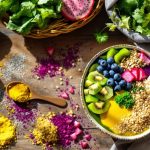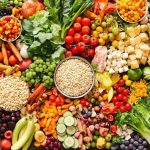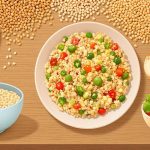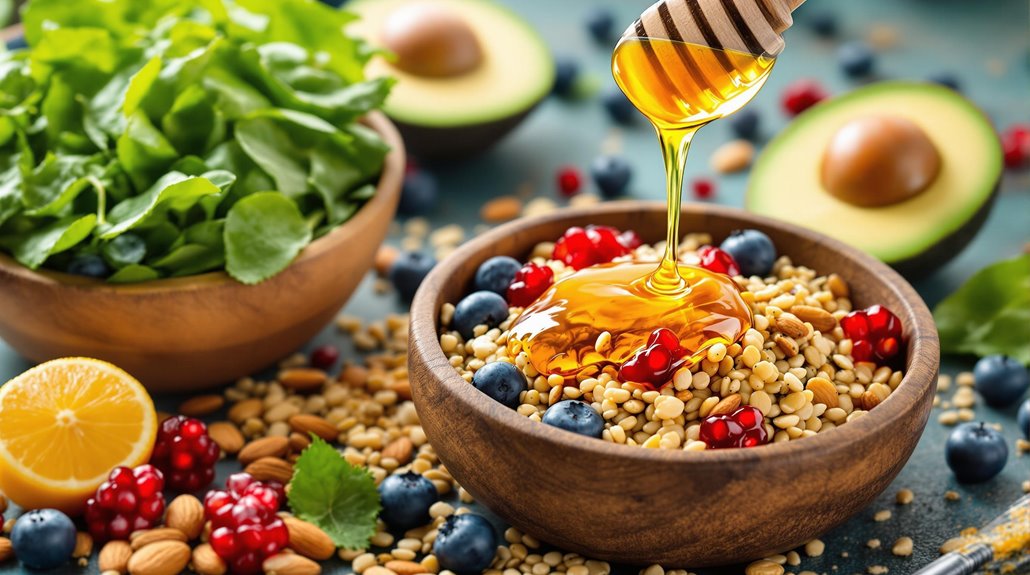
Boost your meals by choosing nutrient-dense superfoods like berries for antioxidants and avocados for healthy fats. Mix things up with diverse ingredients—swap white rice for quinoa and combine greens, beans, and citrus for a nutrient punch. Keep an eye on portion sizes using visual cues like a fist for carbs and palm for protein. Explore different preparations by sautéing kale or baking colorful potatoes to retain nutrients and flavor. Pair foods wisely; try black beans with red bell pepper to boost iron absorption. Embrace these tips for a flavorful and health-enhancing culinary journey.
Choose Nutrient-Dense Superfoods
To navigate the vibrant world of superfoods, focus on selecting those rich in nutrients to optimize your health. Embrace the superfood benefits that enhance your freedom to live vibrantly.
Prioritize berries like blueberries and strawberries, which are packed with antioxidants and vitamins, boosting your immune system. You’ll find that avocados deliver healthy fats and fiber, supporting heart health and aiding nutrient absorption. The vitamin C and flavonoids in citrus fruits like oranges and grapefruits empower your immune system, providing a natural zest for life.
Incorporating fish like salmon and sardines into your diet can do wonders for your heart and brain, thanks to their omega-3 fatty acids. Their high protein content also guarantees you’re fueling your body with efficiency. Leafy greens like kale and spinach are teeming with vitamins and minerals designed to sharpen cognitive function; broccoli, in particular, is packed with vitamins C, K, and folate, and can be a stellar addition to your meals.
Eggs serve as another excellent choice, offering a complete protein profile along with essential vitamins, enriching your daily nutrient intake effortlessly. The heme iron found in animal-based foods like eggs and fish can also enhance your body’s ability to absorb additional iron from other sources efficiently.
Don’t overlook the power of veggies. Leafy greens like kale and spinach are teeming with vitamins and minerals designed to sharpen cognitive function.
Meanwhile, mushrooms deliver immune-boosting goodness, rich in vitamin D and antioxidants, ready to support your body’s defense system and capture the essence of pure vitality.
Balance With Diverse Ingredients
When it comes to crafting a nutritious and tasty diet, balance with diverse ingredients becomes essential. You’ve got the power to transform your meal planning by embracing variety. Start by integrating different superfoods like berries, legumes, and cruciferous vegetables. This colorful mix not only excites your taste buds but elevates your health game, too. Don’t worry about sticking to a rigid diet—flexibility is your friend. Soluble fiber found in superfoods helps manage cholesterol and blood sugar levels, enhancing your health benefits. Use ingredient swaps to keep things interesting, like replacing white rice with nutrient-packed quinoa or snacking on crunchy almonds instead of chips. While embracing diverse ingredients, remember that superfoods are especially high in nutrient density, offering a boost to your overall health.
Here’s a handy table to inspire your ingredient swaps:
| Swap This | For This |
|---|---|
| White Rice | Quinoa |
| Croutons | Nuts |
| Sour Cream | Greek Yogurt |
| Butter | Olive Oil |
Balancing meals becomes simple with a bit of creativity. Combine berries with yogurt and nuts for an energizing snack or toss leafy greens in your salads for a vitamin boost. Remember, relying on a single superfood won’t cut it; moderation and variety are your allies. Cultivate a diverse diet to reduce health risks, and you’ll feel liberated from meal monotony. Embrace this approach, and watch your meals transform into nutritional powerhouses.
Focus on Portion Sizes
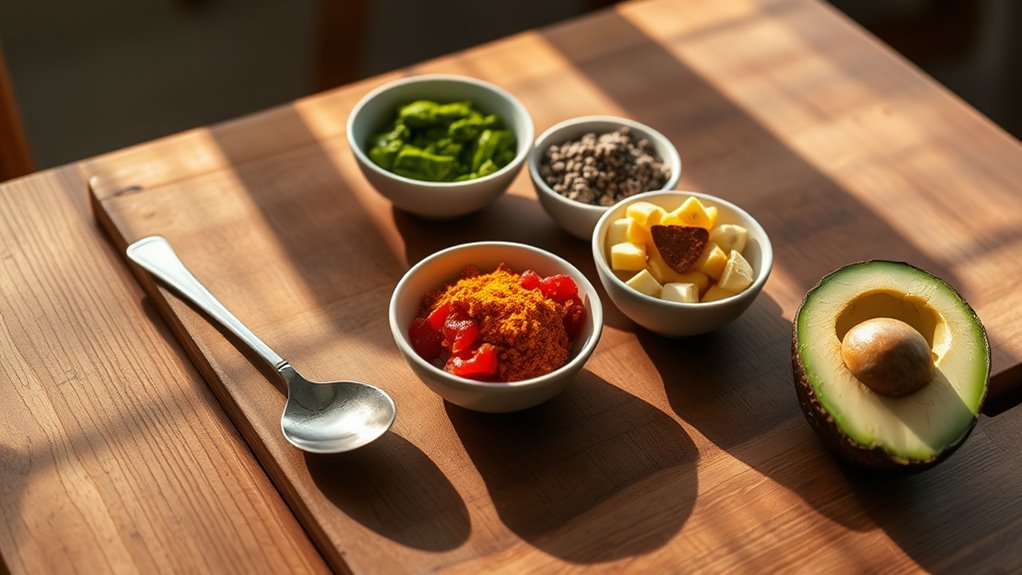
Portion sizes might be the invisible barrier between you and better health. Embracing portion awareness frees you from the constraints of unhealthy eating habits. It’s not about rigid restrictions but achieving freedom through serving control.
Let’s break down the essentials:
- Understand Portions vs. Servings: A serving size is what’s listed on Nutrition Facts labels, whereas a portion is how much you actually consume. Recognizing this difference is vital for serving control.
- Visualize Portions: Use your hand as a guide. Imagine one palm for protein, a fist for carbs, and a cupped hand for fruits or veggies. This helps keep your portions in check and makes dining out manageable. Dietary fiber is another component that can play a role in helping you feel full and satisfied, and it’s beneficial to incorporate it into your meals where possible.
- Plate Strategy: Fill half your plate with vegetables, focusing the remaining space on balanced protein and carbs. Enhance portion awareness by visually dissecting your meal before diving in. A medium fruit is typically the size of a fist, which can help you gauge the amount of fruit to include in your meals.
- Manage Portions at Restaurants: Cut through oversized dishes by ordering half portions or sharing meals. Packing a portion for later guarantees you enjoy without overindulging.
Approach these tips as stepping stones to freedom. By mastering portion awareness, you release a more balanced lifestyle where indulgence meets health in perfect harmony.
Explore Different Preparations
While exploring different preparations, you release the full potential of superfoods by adjusting cooking methods to boost their nutritional benefits. Embrace the freedom of experimenting with cooking techniques to enhance both flavor and nutrition. Sautéing kale with olive oil not only retains essential polyphenols and carotenoids but also adds a savory depth. Baking purple potatoes with turmeric or curry powder accentuates their vibrant health benefits, preserving rich anthocyanins while introducing additional phytochemicals. Marula oil can protect against environmental damage, making it a versatile addition when exploring various culinary techniques. Consider that baking prevents nutrient loss compared to boiling for potatoes, ensuring a healthier dish. Don’t just stop at kale and potatoes—remember to chop onions and let them sit before roasting to produce health-giving sulfur compounds, or grill peppers with oil to increase phytochemical absorption. Lightly peel and roast carrots with oil to protect those nutritious polyacetylenes near the edge.
Meal storage is essential, so liberate your schedule by practicing batch cooking. Prepare large portions of these superfoods, then split them into freezer-friendly containers for future enjoyment.
Maintain nutrient integrity by keeping cooked meals in the fridge at 40°F or below, or freeze them at 0°F. When it’s time to savor your creations, thaw safely and reheat with precision to retain their flavorful importance.
Pair for Maximum Benefits
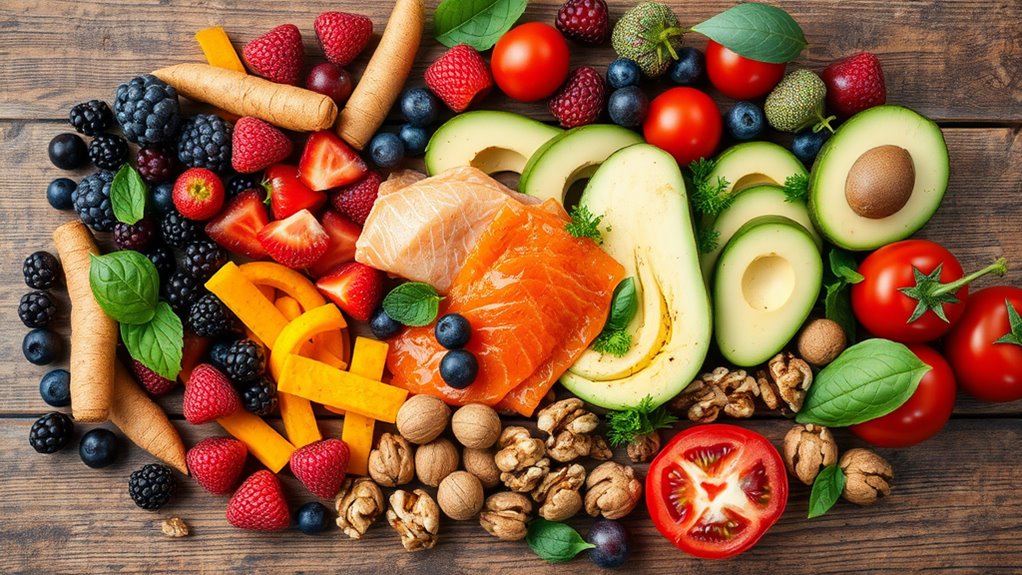
In the quest to maximize the benefits of superfoods, pairing them thoughtfully can reveal even greater nutritional potential. By combining them wisely, you open up a universe of superfood synergy and guarantee peak nutrient absorption, setting your spirit free from the chains of mundane meals.
Harness these powerful combinations for a nutrient-packed diet:
- Black Beans + Red Bell Pepper: The Vitamin C in red bell peppers skyrockets the iron absorption from black beans by six-fold. This powerful pairing floods your body with essential nutrients, fueling both your mind and body.
- Tomatoes + Olive Oil: Olive oil enhances lycopene’s antioxidant power in tomatoes. With each bite, you’re revealing a treasure trove of health benefits that goes beyond just flavor.
- Turmeric + Black Pepper: Piperine in black pepper boosts curcumin’s bioavailability by 1000 times. Release this potential and empower yourself by blending these two in your dishes, covering long-standing traditions with modern health benefits.
- Berries + Yogurt: Bring fiber and antioxidants together with the probiotic wonders of yogurt. This combination not only tickles your taste buds but also enriches your gut health, setting a foundation for overall wellness.
Considering the thermic effect of food(https://www.verywellfit.com/what-is-the-thermic-effect-of-food-5184719) when consuming high-protein foods like Greek yogurt can enhance metabolism while optimizing digestion. Embrace the liberation offered by thoughtful superfood pairings!
Boost Health With Chia Seeds
Embracing chia seeds in your diet can be a transformative step toward enhancing your overall health. These tiny seeds pack a substantial nutritional punch, offering high fiber, omega-3 fatty acids, protein, and an array of essential minerals. Their rich antioxidant profile enables them to combat inflammation and oxidative stress effectively.
Incorporating chia seeds into your meals can lead to better heart health, improved blood sugar regulation, and even support weight management by promoting feelings of fullness. Furthermore, their impact reaches beyond nutrition, with potential therapeutic applications in treating conditions like cancer and high blood pressure.
Chia seeds are immensely versatile and can easily be integrated into everyday meals, from breakfast to dessert. Stirring a tablespoon into a smoothie, oatmeal, or yogurt provides an easy way to boost your intake of essential nutrients.
As a key component in recipes like chia pudding, energy bars, and even baked goods, their gel-forming ability adds texture and satiety while amplifying nutritional value. The potential benefits of chia seeds also extend into pharmaceutical and agricultural fields, as ongoing research continues to explore their bioactive peptides and genome sequencing to enhance their health-promoting properties.
As you explore new culinary adventures, consider including chia seeds for their diverse health benefits and potential therapeutic applications, making them a worthy addition to any balanced diet.

